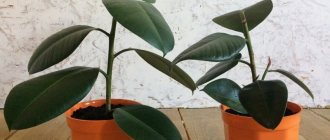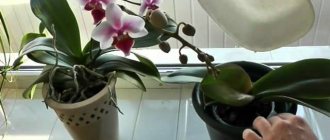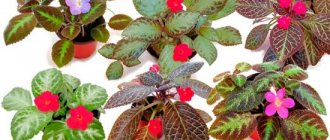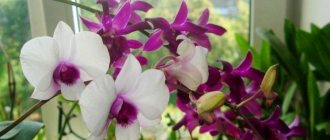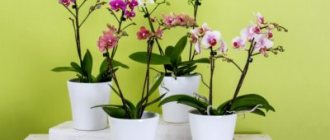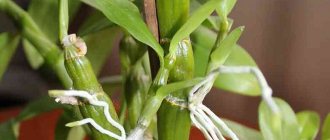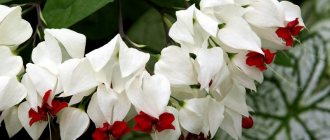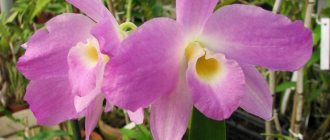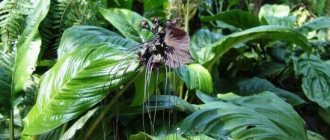Botanical description
The unsurpassed beauty of Dendrobium nobile
nobile leads an epiphytic lifestyle and grows at an altitude of 1800 m above sea level in the Indian state of Sikiim.
Dendrobium is a sympodial orchid. This means that after the mother plant dies, daughter shoots appear in its place. They are the ones who continue the life of the plant.
The roots are hard and white. At the base of the straight stem there are cylindrical pseudobulbs. The alternate arrangement of lanceolate or linear leaves is characteristic.
Flower buds are located in the axils of the leaves. The life of each shoot is short - only 2-3 years. Then death occurs.
Fragrant snow-white, lilac, orange, red, yellow flowers densely cover long shoots. Thanks to breeding work, hybrid varieties with three-color colors have been developed.
Dendrobium noble is a bestseller. Before it goes on the store shelf, it is grown using stimulants. Therefore, after purchase, it can also bloom beautifully several more times. Then you will have to organize proper care for it in order to enjoy its flowering.
Description of the appearance of Dendrobium
An adult dendrobium reaches 50-90 cm in height.
The root system consists of a rhizome - a kind of shoot that unites pseudobulbs.
Pseudobulb is a type of stem in Orchidaceae. This is an organ that stores substances and water necessary for growth. It can be ovoid, spherical and cylindrical.
Peduncles and leaves extend from the top of the dendrobium pseudobulb. The leaves are long, lanceolate and leathery (5-15 cm), alternately located on the stems.
Peduncles emerge from the leaf axils. Each of them contains about 1-6 flowers (5-9 cm in diameter). The color of the flowers can be white, yellow, red, or purple, lilac, and there are also two and three-color varieties.
Dendrobium orchid species
Dendrobium - the most beautiful flower
Among the variety of species and varieties of orchids, it is impossible to single out any special variety that would gain universal popularity. They are all beautiful in their own way.
Dendrobium nobile
Photo: Dendrobium nobile
Dendrobium nobile is native to Vietnam and the Himalayas. Shiny thick pseudobulbs are characterized by rapid growth and reach 0.5 m in length already in the first year of life. In the next season, flower stalks are formed, of which there are from 1 to 3 on one plant. The flowers are large, rich in color, up to 10 cm in diameter.
The natural-looking flowers are pure white, the tips of the petals are tinged with purple, the lip is cream, and the throat is dark purple in color. Hybrids have different colors and bloom several times a year.
Dendrobium phalaenopsis
Dendrobium phalaenopsis
Dendrobium phalaenopsis The orchid got its name due to the identical shape of flowers with phalaenopsis. Naturally distributed in Australia.
Pseudobulbs, together with leathery glossy leaves, reach 0.7 m in length. The species simultaneously forms up to 10 flowers, 8 cm in diameter, which are located on a high peduncle. More often the petals are painted burgundy.
Flowering is long-lasting, up to 2 months. It falls at the end of November - beginning of December. Several peduncles may appear on the same pseudobulb in one season. The best type for novice gardeners.
Dendrobium moniliforme
Dendrobium moniliforme
Dendrobium moniliforme Moniliforme is a noble dendrobium in miniature. The stem of the bush reaches no more than 15 cm in height, the rosette is very beautiful. Inexperienced gardeners should have this species at home, as it is easy to care for, especially since it blooms with beautiful “butterflies”.
Dendrobium parishii
Dendrobium parishii
Dendrobium parishii The hanging shoots of an epiphthous plant reach 0.3 m in length. There are also more powerful specimens.
The pointed oblong-lanceolate leaves grow up to 12 cm in length. Single flowers, painted in an amethyst-purple tone, bloom on the dendrobium. The rounded lip is densely strewn with purple-brown spots, the anther is purple, the column is snow-white. Characterized by summer flowering.
King's Dendrobium (Dendrobium kingianum)
Dendrobium kingianum
King's Dendrobium (Dendrobium kingianum) Native to Australia. The lower part of the cylindrical stems has a noticeable thickening, and at the top of the stem there are wide leaves.
Flowering is abundant, buds are formed in large quantities, in February. At this time, the King's dendrobium produces a long peduncle, on which 5 pink flowers bloom, exuding a pleasant aroma.
Dendrobium densiflorum
Dendrobium densiflorum
Dendrobium densiflorum is found naturally in the Himalayas. Unusual coloring. All flowers have a rich orange color, which even slightly hurts the eye. Flowering is very abundant. Up to 50 flowers can bloom simultaneously on racemose inflorescences 0.3 m long.
You can learn more about representatives of the orchid family from the video below.
Names of indoor varieties with photos and descriptions
The Dendrobium orchid has many varieties, we will tell you more about them.
Noble, or Nobile
At the beginning of growth, erect pseudobulbs are present on the plant. Mature pseudobulbs gradually shed their leaf blades and become yellowish.
After 3–4 years, the bulbs completely die off, and babies appear on their tops. Flower color ranges from pink to lilac. Foliage size is 7–10 cm.
White Apollo
The variety has a subspecies - Nobile Apollo. It is distinguished by fleshy glossy stems. It grows in height up to 150 cm. It blooms in the second year after transplantation, the petals are white.
Read more about the Dendrobium Nobile variety in this article.
Kinga or kingianum (Kingianum)
The variety is easy to care for and grows compactly. The birthplace of culture is Australia. The plant develops as a lithophyte. From pseudobulbs shoots grow, on which sessile leaves are located. Peduncles are a continuation of the stems. Flowers can be pink, red, lilac and white.
Lindley, yellow or aggregum (Lindleyi)
It is distinguished by its miniature size - only 10–20 cm in height. Pseudobulbs are 5–10 cm long and can grow in different directions or lie flat. The foliage remains on the shoots for one season.
Peduncles can grow up to 25 cm, they are curved or completely twisted. In one inflorescence there are up to 15 cm, relative to the entire plant they are considered large. The color of the petals is yellow or orange.
What other yellow orchids are found in nature? Read in this article.
Hibiki
A long-flowering variety that grows compactly. The height of a mature plant does not exceed 15 cm. The bulbs are reddish in color, short, and dark green leaves grow from them. Development is slow. The inflorescence collects 6–8 buds.
Sa Nok or Sanuk (Sa-Nook)
The height of the crop is 60 cm. The variety is a hybrid bred by Thai botanists. It is unpretentious in care, but it blooms magnificently and for a long time. The buds are white, lilac or burgundy. It is distinguished by a thin peduncle, at the top of which 2–3 buds bloom.
At the base of the leaves there are pseudobulbs in which nutrients accumulate.
Moniliforme
This variety is a smaller copy of Dendrobium Nobile. It grows up to 15 cm, and is absolutely unpretentious in cultivation. It will tolerate even direct sunlight and the absence of daily temperature changes. Each pseudodulba grows 1–2 inflorescences, emitting a light, subtle aroma.
The variety has many hybrids.
Star mix
A hybrid fully adapted for growing at home. There are a variety of colors, height - 70–90 cm, depending on the subspecies. They rarely get sick and bloom for a long time.
Berry Oda
The main difference between the species is the ability to grow even at high temperatures. Thickened stems grow from pseudobulbs. It does not grow more than 40 cm in height. It blooms with small buds for six months.
Read more about the Berry Oda dendrobium variety and its care here.
Bellatulum or beautiful (Bellatulum)
The stems grow up to 7 cm, each of them has fleshy and long leaf blades. It blooms twice a year - at the beginning of spring and at the end of summer. The flowers grow no more than 3 cm in diameter, the petals are white and the lips are yellow. The center of the plant is red. The beautiful dendrobium loves fresh air and good lighting.
Stardust or orange (Stardust)
It is distinguished by elongated pseudobulbs, which shed their leaves at maturity and become yellow. After 3–4 years, the pseudobulbs completely die off. Leaf blades are lanceolate. The inflorescences are short, containing 2–4 flowers. The color of the petals is yellow-orange, and there is a venous pattern on the lips.
Roy Tokunaga
Characterized by white petals and the same lip with lilac splashes. It grows up to 50 cm in height, in rare cases - up to 70 cm.
Farmeri
Epiphyte of sympodial type, grows up to 45 cm in height. Pseudobulbs are fusiform, up to 40 cm high, straight. They are swollen at the base and tetrahedral at the top. At the top of the bulbs grows up to 4 oval-shaped leaves up to 15 cm long.
Up to 35 buds can be collected in one inflorescence, each with a diameter of 3–5 cm. The color of the petals is white, yellow, pink and purple.
Jenkins
Miniature epiphyte (grows no higher than 10 cm). Pseudobulbs germinate in small groups. The leaves are thick, oval, 3–5 cm long, and live on the plant for 2–3 years. There are only 1–2 buds on the peduncle, each 3 cm in diameter. They stand out noticeably against the background of the entire plant.
Spectabile or prominent (Spectabile)
Depending on the conditions of care, the length of the plant varies between 30–130 cm. The shoots at the base are thick and fleshy, tapering upward. On each shoot, up to 6 fleshy, pointed leaf plates appear, the length of which reaches 20 cm.
The flowers are large, up to 8 cm in diameter. They are brown-green and cream, covered completely, except for the edges, with dots and veins of purple or reddish-brown color.
Loddigesii
The crop grows up to 18 cm. One plant has a lot of foliage, it is shiny, fleshy, and rich green in color. Peduncles appear after the leaf blades fall off. The flowers are large relative to the entire plant. The petals are purple and the sepals are purple-pink.
The plant retains flowers even in cool conditions.
Akatsuki
The height of the crop is 35–45 cm. It prefers to grow in well-lit areas. It blooms once every 6 months, the buds last for a month. The color of the petals is purple, and the middle of the bud is white and yellow.
Parisha (Parishii)
The culture is characterized by rapid growth. After just a few months, the plant will reach adult size. There are a large number of thickened nodes on the pseudobulbs. In dry climates they are straight, and in humid climates they are curved.
The leaves are glossy, leathery, and gradually fall off. Peduncles grow after the leaves fall.
Burana Twist
The hybrid grows up to 30–40 cm. The flower is large - up to 9 cm in diameter. It can bloom at any time of the year. Easily adapts to home growing conditions. The flowers are of an unusual color (purple intertwined with yellow, brown, lilac) and remain on the peduncle for a long time.
Delicatum
A hybrid of two varieties. Characterized by medium size. The foliage is dark green in color and feels similar to the leaves of a date palm. Flowering begins in spring and lasts only 2–3 weeks, but the buds bloom profusely.
The variety is ideal for beginning gardeners due to its ease of care.
Mini
The culture received its name due to its size. Usually shoots do not grow more than 10 cm. The color of the petals is white, pale yellow, orange.
What other varieties of mini-orchids are suitable for home growing? Read in this article.
Queen Victoria's or purple
The height of pseudobulbs depends on care factors (maximum growth is 1.2 meters). The leaves are relatively small (only 6 cm), pointed, and shine glossy in good light. Over time they fall off.
Inflorescences grow on the nodes of the pseudobulbs. 2–6 buds appear on one brush (in rare cases - 12). One part (thin) of the petals is white, and the upper part is violet-blue.
Trantuanii
The variety was discovered relatively recently - in 2004. Differs in miniature sizes. The stems are low and flat. The flowers are relatively large - their diameter is 4–5 cm, white in color. The buds bloom in early spring. The main thing in care is to provide warmth and good lighting.
Bush, deciduous - that's all about it
Dendrobium is often called a bush orchid. The plant received this name for the shape of the inflorescence. They are different in structure: spike, earring, panicle, brush, and also differ in size.
The deciduous species of dendrobium includes a number of plants that completely shed their leaf blades during the dormant period. They all differ in height, number and color of flowers.
Dendrobium: planting and care
Dendrobium orchid
By providing the plant with proper care, it will delight you with its flowering several times a year.
Features of cultivation: caring for a dendrobium orchid after purchase
White orchid flowers
After purchase, home orchids delight the owner with luxurious flowers for a long time, and it seems to the gardener that this will always be the case. But! Not so!
The fact is that cultivation for industrial purposes is carried out using growth and flowering stimulants. Long-acting fertilizers provide the flower with useful substances necessary for normal development for only a couple of months. Therefore, after bringing the dendrobium home, the maximum number of times it can still bloom on its own is once.
To enjoy frequent and long-lasting flowering, it is necessary to adhere to agrotechnical cultivation and care practices.
Content temperature
Variety of varieties
Active growth of the orchid is observed in conditions of moderate temperature. During the growing season, you will have to maintain the temperature at +20-25°C. It is important that the night temperature differs from the day temperature. At night +15-18°C is enough.
Therefore, the best choice would be a balcony or veranda. Daytime and nighttime temperature differences provide the plant with the formation of flower buds, which will contribute to lush flowering in winter. The plant will also grow better.
In autumn, growth slows down, so it is important to follow the life cycle of the plant, it is advisable to reduce the temperature regime. During the day you need to maintain +12-15°C, at night – +10°C is enough. This is a must .
In addition to lowering the temperature, for further flowering it is necessary to place the pot with the dendrobium orchid on the brightest windowsill or organize artificial lighting.
Too high a temperature will cause the roots to stop drinking water . Consequently, the leaves will dry out.
Lighting
Tropical beauty prefers bright but diffused light
A window sill on the south side is not the most suitable place for dendrobium, since the plant is harmed by temperatures above +27°C. The south side is suitable for keeping orchids only in late autumn and winter. If there is a lack of natural light, the pot with the plant must be illuminated with fluorescent lamps 4 hours a day.
The color of the leaves signals whether there is sufficient or insufficient natural light.
Green foliage is the norm. A light green color indicates that the plant has a lot of light, while a dark green color indicates a lack of light. If there is absolutely not enough light, the leaves become deep yellow.
Watering rules and maintaining humidity
Diffused lighting and moderate watering are the main conditions for successful growth.
During the period of active growth, the plant needs 2 waterings. In autumn, once a week is enough, and in winter – once a month. Watering an orchid at rest should be done carefully so as not to destroy the plant. It is best to water using the immersion method, that is, the pot with the mother plant is immersed in another container with warm water poured into it.
When watering, it is important to ensure that water does not fall on young pseudobulbs, otherwise they will rot.
When keeping it in an apartment, you should remember that dendrobium comes from a hot tropical climate with high humidity , so at home you should organize approximately the same conditions for it.
To soften dry air and increase air humidity, it is recommended to mist the foliage daily. It is necessary to ventilate the room. The pot with the plant can be placed on a tray with wet pebbles or expanded clay, or sphagnum moss can be placed.
Lack of moisture also affects the quality of the leaf blades - they grow twisted and wrinkled.
Transfer rules
Dendrobium transplant
An orchid is replanted once every 3 years. A signal that a transplant is necessary are roots protruding from the drainage holes.
In addition, it is necessary to replant if the soil has oxidized or the light-loving plants have become ill.
You need to replant carefully, into a special substrate. The soil contains bark, moss and foam balls.
Dendrobium roots are fragile and brittle, so it is important to be careful when replanting.
Transplanted into special pots for orchids. A drainage layer of large pieces of pine bark is poured onto the bottom of the container, then moss is placed, then the plant is replanted and covered with a new substrate. Watering is needed no earlier than a week after transplantation.
Fertilizer application
Dendrobium in a pot
Fertilizing is applied during the period of vegetative growth, starting in April and ending in September. You can feed once a week or 2 times a month. The concentration of applied fertilizers depends on the frequency of fertilizing. The more often feeding is carried out, the weaker it should be.
Houseplant care
This type of orchid is whimsical and requires special care; there are also some vagaries that must be fulfilled for the full development of the plant. The most common of them are:
- Lighting. Orchid loves bright light.
- Temperature. It is necessary to observe the temperature regime for rapid flower growth.
- Watering. You can’t overwater the plant, but you also can’t let it dry out.
- Fertilizer feeding. For full development and to protect the orchid from diseases.
- Maintain indoor air humidity. If the air in the room is dry, the plant will dry out.
To learn how to properly care for your Dendrobium orchid, you need to consider each of the above points. Let's get acquainted with them in more detail.
Lighting
This is the most important moment of caring for a flower at home. Any variety of orchid, including Dendrobium, is very photophilous and needs a lot of bright light. Since this is necessary for its flowering, especially for varieties with bright colors. Daylight hours should last at least 12 hours.
In the autumn-winter period, as a rule, additional lighting sources are used - lamps. If there is insufficient lighting, Dendrobium will not be able to please you with its bright, beautiful blooms.
Reference. The Dendrobium orchid, unlike other species, does not need to be turned to the light in different directions.
Temperature
Moderate temperature for active growth of this type of orchid is from 17 to 25 degrees.
At night, the optimal temperature is no higher than 21 degrees. Types of cool keeping in the spring-summer period require a temperature of 15 to 18 degrees during the day, and about 12 degrees at night. In autumn and winter, the orchid needs a room temperature of 12 to 16 degrees. Extremely sudden temperature changes for an orchid can have a detrimental effect on its development.
Therefore, frostbite of the flower should be avoided to avoid unwanted effects.
How to water and feed correctly?
Watering and fertilizing for this type of orchid is no less important than other types of care. Dendrobium needs to be watered in different quantities at different times of the year. In spring and summer, the plant in the pot should be moistened abundantly. And autumn and winter is a dormant period for orchids, so watering should be more sparse. The main thing is that watering is carried out with settled or boiled water at room temperature.
But as for feeding, it also needs to be done at a certain time. It is advisable to produce it from April to September using complex mineral fertilizers. As a rule, fertilize the substrate once every 10–15 days.
Important! It is necessary to purchase fertilizers that are suitable specifically for this type of orchid.
The video below describes the rules for watering dendrobium:
Air humidity
The optimal air humidity for this plant should be from 50 to 70%. Therefore, during the winter heating season, the bush should be sprayed with warm water as often as possible. Since it is in winter that the air in the room is dry, and this can have a detrimental effect on the plant. During this period of time, it is best to place the flower pot on a tray filled with damp crushed stone.
It is necessary to spray the above-ground part 1-3 times a week, depending on the air humidity in the room.
Features of flowering
Flowering takes place in the last months of winter and spring. To admire the blooms, proper care is necessary at this time.
How to care during flowering?
Photo of an orchid: gorgeous bloom captivates the eye
In order for an adult plant to feel comfortable and produce a peduncle, it is necessary to ensure the correct development cycle, which should include a phase of active growth and rest. If these conditions are neglected, instead of a peduncle, the orchid will delight the owner with young shoots - children that will develop from the pseudobulb.
Thanks to breeding work, you can see different colors of dendrobium flowers. Flowering lasts from 2 weeks to 1.5 months.
In January, you need to reduce watering and move the pot with the plant to the most illuminated place. But the plant can get burned from direct sunlight.
If flower stalks do not want to appear, flowering can be stimulated by applying phosphorus-containing fertilizer.
If this does not help , the dendrobium is given a shower with optimal water at a temperature of +35-40 degrees, no more.
How to care after flowering?
Orchid transplant
Only in some plants the foliage falls and the dendrobium enters a dormant period, preparing for a new flowering.
After flowering, you need to cut off the peduncle if it has changed its color, reduce watering and place it on the windowsill in a cool room. Constantly wet soil will cause the rhizomes to rot.
In its natural environment, dendrobium is always in active growth. Therefore, if the plant has not gone into hibernation, it is recommended to provide additional lighting by installing a phytolamp above it.
Growing problems
When properly maintained, the dendrobium flower rarely gets sick and is practically not affected by pests. Suboptimal care can cause sunburn, root rot, bacterial leaf spot, and insect infestation.
The leaves are turning yellow
Yellowing and loss of leaves after flowering is a natural process in deciduous species of the Dendrobium genus.
If the leaf blades lighten and then dry out before or during flowering, then this is a cause for concern. The cause may be direct rays of the sun. Orchids need to be shaded during the summer at noon, as too intense light causes burns.
Lack of lighting and waterlogging of the substrate lead to lightening of the leaves. Bacterial spot is characterized by brown spots appearing on the undersides of leaves.
Flowers and buds fall
The reason for the loss of buds and flowers is excessive watering. The substrate should be treated with a fungicidal preparation (for fungus) and watering should be reduced. In spring, the orchid needs to be transplanted into fresh substrate.
A common cause of yellowing, drying and falling flowers is too high a temperature in the room where the plant is kept.
It is important to comply with the cultural requirements for temperature conditions not only during the dormant period. The optimal temperature during flowering of the Dendrobium orchid is from 22 to 25°C.
Doesn't bloom for a long time
Creating conditions for a dormant period is important to prepare the Dendrobium orchid for flowering. It happens that there are no flowers for 1 year or more, new pseudobulbs grow, but they are long and thin. This is a sign that when caring for the Dendrobium nobile or kinga orchid, they did not take care of good lighting.
A common reason for the absence of flowers for a long time is excess nitrogen in the soil. It is necessary to reduce fertilizing with nitrogen fertilizers.
Try succinic acid fertilizer for orchids. Perhaps this is what your flower is missing.
At high temperatures and lack of light, babies form on the orchid, but there are no flowers. It is recommended to move the flower pot to a better lit place - to the windowsill of an east or west window.
Reproduction methods
Dendrobium orchid - propagation at home
Dendrobium propagates by cuttings and dividing the bush.
Dividing the bush
Dividing the mother bush
It is recommended to divide the bush in the spring, after the plant has flowered. Usually this process coincides with transplantation.
How to do division step by step: basic rules?
- The mother plant needs to be removed from the pot, shake off all the soil
- Then you need to untangle the roots, and very tangled ones will have to be cut with a sharp knife
- When dividing, you need to make sure that each part contains at least 2 bulbs and the same number of sprouts.
The cut must be made with a disinfected knife. It is recommended to powder the cut areas with activated carbon powder.
Cuttings
Dendrobium propagation
1 After the pseudobulb is cut from the mother bush, it must be cut into cuttings 10 cm long.
2 Next, take a bag with a Zip fastener, fill it with nutritious substrate or sphagnum moss, and moisten it.
3 Plant 1 cutting in each bag, zip it up and place it in a bright place .
4 Good rooting is observed at a temperature of + 23-24°C. Further care involves ventilating the mini-greenhouse daily and moistening the substrate as needed.
5 Rooting occurs within 3 weeks. Then you need to transplant into new pots. Rastuski must be protected from the scorching sun. Orchids bloom for 2-3 years.
Reproduction
This species is an evolutionarily established set of individuals characterized by a single ... dendrobium can be propagated by stem cuttings or with the help of young shoots that appear on the stems. Regardless of the method, this must be done during transplantation after the plant has flowered, when new shoots begin to grow. Select a two-year-old shoot, separate it from the mother plant, and cut it into pieces. Cut between the nodes where the leaves grow.
Move the cutting material into damp sand, in a warm place (20-25 ° C) with a high level of air humidity. Make sure that the sand is also constantly moist. It is ideal to place the cuttings in a well-lit, heated mini-greenhouse.
When the young shoots from the cuttings reach a height of 10 cm and take root, transplant them into separate pots. Do not water until new roots appear, but mist.
Possible problems: diseases, pests
Dendrobium orchid
Improper care affects the quality of plant growth and development. At this time, fungal diseases can occur, which lead to death.
Bacterial rot
Bacterial rot
Over-wetting the soil promotes the development of root rot. If this happens, the flower is unlikely to be saved. But you need to try. It will be necessary to immediately transplant the diseased specimen into new soil .
During transplantation, you need to inspect the root system, remove all rotten roots, trim them to healthy tissue. Sprinkle the cut areas with charcoal and place the plant in a pot with new soil.
The reanimated dendrobium cannot be watered for 1.5 weeks!
In addition to various diseases, the orchid and all representatives of the Orchid family are attacked by pests such as spider mites, thrips, and scale insects. Before using insecticides, damaged leaves are removed and the plants are treated.
Dendrobium transplant
Why did the stems wrinkle? If the pseudobulbs wrinkle during the growth of young shoots, then this phenomenon is considered normal and should not be paid attention to.
Shrinking occurs because the young shoots do not yet have their own roots, so their nutrition comes from the mother plant.
During this period, you should not over-moisten the soil, as this will lead to rotting of the roots.
Pseudobulbs shrink during the period before flowering, but watering is also prohibited.
Why did babies appear instead of flowers? Abundant flowering must be preceded by a period of rest, during which certain conditions must be met:
- the pot with the plant should be in a well-lit place, but you need to know that the orchid does not tolerate drafts
- the difference between day and night temperatures should be at least 10°
- Do not water or fertilize
If you do not monitor the plant and start watering it earlier, the flower buds will degenerate into vegetative ones and children will appear.
Proper care is the key to a healthy plant!
What causes leaf fall? If during flowering the leaves turn yellow and fall off (the lower ones) - this is considered normal, the upper ones - it is necessary to observe the flower to find out the cause and determine the disease.
Young shoots grow too thin. That's how it should be. The sprouts become familiar in appearance only after growth stops and pseudobulbs begin to form.
No flowering. If the dendrobium does not bloom, it means the plant is not provided with a sufficient level of light, or it did not have a dormant .
The pseudobulb has turned brown or yellow. The natural state is slight drying, but maintaining the brightness of the green color. Slight yellowing is acceptable. If the pseudobulb turns brown or yellow, it means the roots have begun to rot and will soon begin to die.
For preventive purposes, it is recommended to inspect the plantings more often. Timely inspection of plants will help prevent various diseases and begin timely treatment. Caring for a dendrobium orchid is not at all difficult, and is not much different from caring for other indoor plants. Therefore, do not be afraid to breed it at home.
VIDEO: Flowers. Lesson 2.2. Orchid family. Part 1
Flowers. Lesson 2.2. Orchid family. Part 1
Dendrobium orchid - home care. Common types. What to do with the flower after purchase? Rules of care and reproduction | (110+ Photos and Videos)
5 Total Score
Customer ratings: 5 (1 vote)
Pests and diseases
Shchitovka
Spider mite
Aphids
The dendrobium orchid, like other houseplants, can develop pests or diseases.
Pests of this plant include:
- Shchitovka;
- Spider mite;
- Aphid.
To combat them, special chemicals are used to treat the affected plant.
As for diseases, fungus may occur due to irregularities in the watering regime.
Subtleties of care
Among gardeners it is considered a fairly unpretentious variety of orchid. But the care requirements of dendrobium are still higher than those of most indoor plants.
| Lighting | Photophilous culture. It grows best on a south-facing window with shade during the midday hours. In a different arrangement, the lack of light is compensated for by backlighting. In the shade, the leaves become very dark; when in excess, they become light green. |
| Temperature | During the intensive growth stage, the daytime temperature is about 25°C, the night temperature is about 20°C. It cannot tolerate heat above 30°C and dies. In autumn, they can withstand daily temperature changes of up to 10°C. This stimulates subsequent flowering. |
| Watering | Before watering the dendrobium, check the moisture level of the substrate. In between, it should dry out almost completely. It is recommended to water by immersing the pot in water for 10-20 minutes. |
| Humidity | In hot weather, spray up to several times a day. Place bowls of water and use a tray with wet moss. |
| Feeding | Feed with fertilizers for orchids. Fertilizers are applied throughout the entire period of growth and flowering. For the first and last feeding, the concentration is 2 times less. The frequency of application is every 1.5-2 weeks. |
| The soil | The soil for dendrobium consists of bark (conifers), crushed coal, sphagnum and peat. Before use, the resulting substrate is sterilized - poured into boiling water with the addition of potassium permanganate and dried. You can use ready-made soils for orchids. |
| Transfer | It is difficult to tolerate transplantation. Replant in cases of extreme necessity - when the soil becomes sour, turns into dust, or the flower grows. Replanted at the end of February - beginning of March. |
| Hygiene | The leaves are periodically wiped with a damp cloth as dust accumulates on them. |
| Aerial roots | Do not immerse in the substrate. If the pot is placed on a tray with damp moss or expanded clay, the aerial roots can sink into them on their own. There is no need to prevent this. |
Genus dendrobium
This species refers to representatives that live in nature on trees. Dendrobiums are found in Australia, southeast Asia, and many areas of Oceania. This genus is one of the most numerous in the family. Today, botanists have discovered and described more than a thousand species. Man's first acquaintance with dendrobiums occurred at the end of the eighteenth century. Numerous hybrid forms of this genus differ not only in their color ranges, but also in the shape of lush racemose inflorescences and corollas. They have incredible attractiveness, and some have a unique appearance.
Their elongated lanceolate leaves are not as dense as those of other phalaenopsis. The roots of all representatives of the Dendrobium genus are covered with a coating of wax. In some species, scaly shoots reach four to five meters.
The most striking and famous representative of this genus is considered to be Dendrobium nobile, the photo of which is presented below. This orchid has become widespread for its incredibly beautiful flowering and unpretentious nature.
